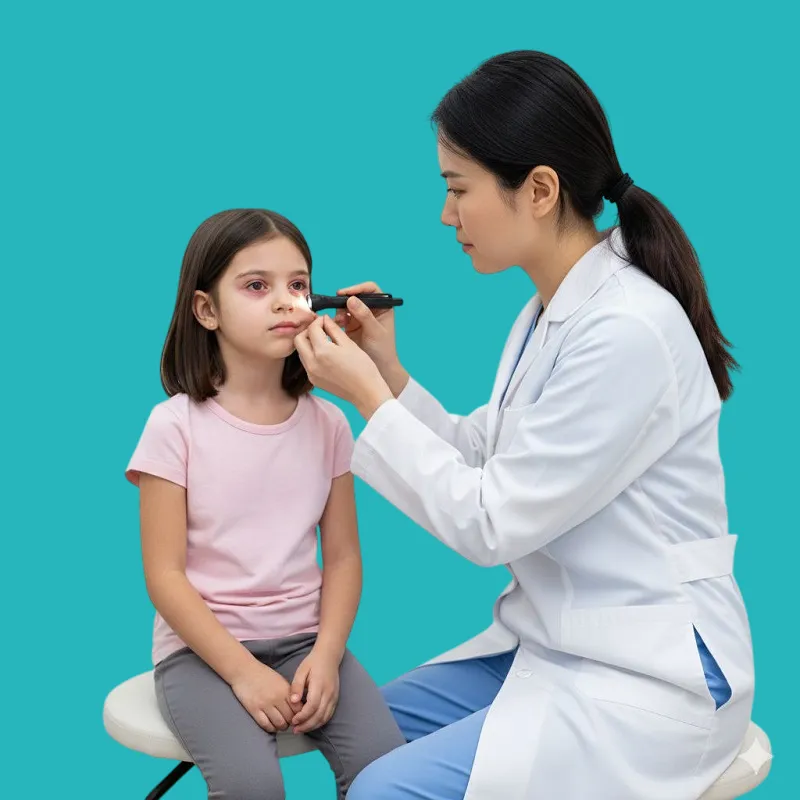Eye infections in children are a common problem that causes redness, inflammation, and abnormal discharge in the child's eye.
Treatment for eye infections aims to control the inflammation, reduce the spread of infection, and improve the child's comfort quickly and safely.
What are eye infections in children?
Eye infections in children are inflammations of the conjunctiva or eyelids caused by bacteria or viruses, resulting in redness and bothersome discharge.
Eye infections cause noticeable eye irritation and can spread easily if not treated properly.
Causes of eye infections in children

There are many causes of eye infections, and they can easily spread among children, such as:
- Exposure to bacteria by touching the eyes with the hands.
- Viral transmission in schools and nurseries.
- Using shared or contaminated towels.
- Severe allergies that lead to eye irritation.
Symptoms of eye infections in children
The symptoms of eye infections are clear and easily noticeable, including:
- Severe redness of the eye.
- Yellow or white discharge.
- Sensitivity to light.
- Mild swelling of the eyelids.
How to Diagnose an Eye Infection
Diagnosing an eye infection depends on a doctor's careful examination of the symptoms, including:
- Assessing the severity of redness and discharge.
- Asking parents about the onset of symptoms.
- Examining the conjunctiva and eyelid.
- Taking a swab if the infection is severe.
Treating Eye Infections in Children
Treating eye infections in children aims to eliminate the underlying cause of the inflammation, such as:
- Using antibacterial eye drops or ointments.
- Antiviral medications in cases of viral infections.
- Cleaning the eye with warm water to remove discharge.
- Avoid using any medication without a doctor's prescription.
Treating Eye Infections at Home
Some safe home remedies can help soothe the symptoms of an eye infection, such as:
- Applying warm compresses to reduce inflammation.
- Washing hands frequently before touching the eye.
- Using a separate towel for the child.
- Maintaining good hygiene for the face and eyes.
When to See a Doctor?

There are cases of eye infections that require prompt medical attention, including:
- Symptoms persisting for more than two days.
- Frequent, thick discharge.
- Vision impairment or severe light sensitivity.
- Fever in the child with the infection.
Complications of eye infections in children
Neglecting to treat an eye infection can lead to more serious problems, such as:
- Spread of the infection to the healthy eye.
- Chronic eye irritation.
- Temporary vision problems.
- Transmission of the infection to other children.
How to prevent eye infections
Simple steps can help prevent eye infections and reduce their spread, including:
- Washing hands frequently.
- Avoiding sharing towels and personal items.
- Gently cleaning the eye if discharge appears.
- Teaching children not to touch their eyes.
Frequently Asked Questions
Are eye infections in children easily transmitted between children?
Yes, they are easily transmitted through touch or sharing items, especially in schools and nurseries.
Can eye infections in children be treated without antibiotics?
Some viral infections improve on their own, but bacterial infections require appropriate antibiotics.
Are compresses helpful in treating eye infections in children?
Yes, warm compresses help reduce inflammation and clear discharge.
When are eye infections in children serious?
When they affect vision or are accompanied by severe swelling or high fever.
Article Summary
Eye infections in children are among the most common eye problems and can be easily treated with appropriate eye drops and attention to daily hygiene.
Preventive measures such as handwashing and avoiding sharing personal items help protect the child, reduce the spread of infection, and promote faster and safer recovery.